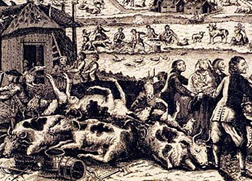 Veterinary medicine as a profession was born 250 years ago in Lyon, France, with the founding of the first school of veterinary medicine.
Veterinary medicine as a profession was born 250 years ago in Lyon, France, with the founding of the first school of veterinary medicine.
This year, the World Veterinary Association (WVA) has designated 2011 as the “Year of the Veterinarian in honor of the contributions made by veterinary medicine to public health.
“Almost three-fourths of diseases that have emerged within the last twenty years are zoonoses, or diseases transmitted between animals and humans,” said Dr. Leon Russell of Texas A&M College of Veterinary Medicine and Biomedical Sciences, and immediate past president of WVA.
“Veterinarians work hard to prevent zoonoses and are called on to work closely with physicians to help identify cases like these.”
Lyon, two hours southeast of Paris, was an important capital of the Roman Empire and later, a medieval center of Christianity and commerce.
During the late 18th century, Europe was hit with rinderpest, a cattle plague that led to the death of an estimated 200 million cattle, as well as widespread famine as a result of the loss of dairy and beef cattle, and oxen, so necessary for farm work.
In 1761, Louis XV of France assembled a team, led by noted horseman Claude Bourgelat, to form a veterinary school in Lyon and tackle the problem of rinderpest. In 1764, another veterinary school was established in Alfort, outside of Paris.
In the 18th century, rinderpest was thought to be similar to smallpox because of some of its symptoms and because of its virulence. During the same period, smallpox annually killed 400,000 Europeans; in the 20th century, it killed an estimated 300 million people worldwide.
The rinderpest virus (RPV) is more closely related to measles and canine distemper viruses than smallpox, however, it is the only other disease besides smallpox to have been totally eradicated from nature.
On 14 October 2010, the United Nations Food and Agriculture Organization announced that field activities in the decades-long, worldwide campaign to eradicate rinderpest were ending, paving the way for a formal declaration in 2011 of the global eradication of the disease.
Rinderpest was one of more than a dozen agents that the United States researched as potential biological weapons before suspending its biological weapons program.
Although the World Health Organization declared smallpox totally eradicated in 1980, it was agreed that smallpox be kept in two WHO approved laboratories – one in Russia and one in the United States.
Today these stocks still exist at the State Research Center of Virology and Biotechnology in Koltsovo, and at the Centers for Disease Control and Prevention (CDC) in Atlanta. Although the World Health Assembly has passed resolutions to destroy the stocks, each time the date of destruction has been postponed.
There is even concern, raised by defecting Soviet scientists in the late 1980s and early 1990s, that the virus could already be in hands other than WHO’s.
